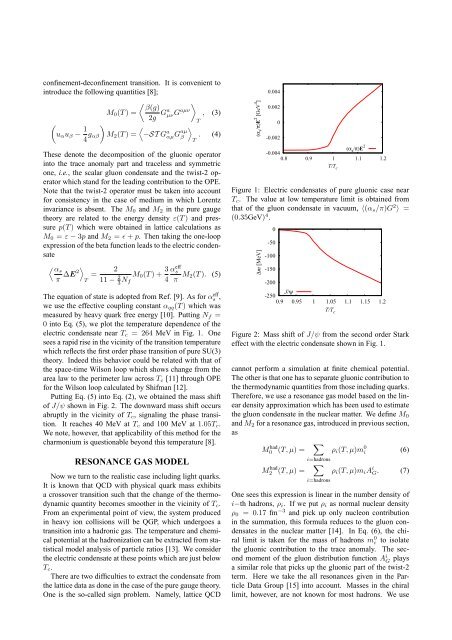Proceedings of International Conference on Physics in ... - KEK
Proceedings of International Conference on Physics in ... - KEK
Proceedings of International Conference on Physics in ... - KEK
You also want an ePaper? Increase the reach of your titles
YUMPU automatically turns print PDFs into web optimized ePapers that Google loves.
c<strong>on</strong>f<strong>in</strong>ement-dec<strong>on</strong>f<strong>in</strong>ement transiti<strong>on</strong>. It is c<strong>on</strong>venient to<br />
<strong>in</strong>troduce the follow<strong>in</strong>g quantities [8];<br />
⟨<br />
β(g)<br />
M0(T ) =<br />
2g Ga µνG aµν<br />
⟩<br />
, (3)<br />
T<br />
(<br />
uαuβ − 1<br />
4 gαβ<br />
) ⟨<br />
M2(T ) = −ST G a αµG aµ<br />
⟩<br />
β . (4)<br />
T<br />
These denote the decompositi<strong>on</strong> <str<strong>on</strong>g>of</str<strong>on</strong>g> the glu<strong>on</strong>ic operator<br />
<strong>in</strong>to the trace anomaly part and traceless and symmetric<br />
<strong>on</strong>e, i.e., the scalar glu<strong>on</strong> c<strong>on</strong>densate and the twist-2 operator<br />
which stand for the lead<strong>in</strong>g c<strong>on</strong>tributi<strong>on</strong> to the OPE.<br />
Note that the twist-2 operator must be taken <strong>in</strong>to account<br />
for c<strong>on</strong>sistency <strong>in</strong> the case <str<strong>on</strong>g>of</str<strong>on</strong>g> medium <strong>in</strong> which Lorentz<br />
<strong>in</strong>variance is absent. The M0 and M2 <strong>in</strong> the pure gauge<br />
theory are related to the energy density ε(T ) and pressure<br />
p(T ) which were obta<strong>in</strong>ed <strong>in</strong> lattice calculati<strong>on</strong>s as<br />
M0 = ε − 3p and M2 = ϵ + p. Then tak<strong>in</strong>g the <strong>on</strong>e-loop<br />
expressi<strong>on</strong> <str<strong>on</strong>g>of</str<strong>on</strong>g> the beta functi<strong>on</strong> leads to the electric c<strong>on</strong>densate<br />
⟨<br />
αs<br />
π ∆E2⟩ =<br />
T<br />
2<br />
11 − 2<br />
3 Nf<br />
M0(T ) + 3<br />
4<br />
α eff<br />
s<br />
π M2(T ). (5)<br />
The equati<strong>on</strong> <str<strong>on</strong>g>of</str<strong>on</strong>g> state is adopted from Ref. [9]. As for α eff<br />
s ,<br />
we use the effective coupl<strong>in</strong>g c<strong>on</strong>stant αqq(T ) which was<br />
measured by heavy quark free energy [10]. Putt<strong>in</strong>g Nf =<br />
0 <strong>in</strong>to Eq. (5), we plot the temperature dependence <str<strong>on</strong>g>of</str<strong>on</strong>g> the<br />
electric c<strong>on</strong>densate near Tc = 264 MeV <strong>in</strong> Fig. 1. One<br />
sees a rapid rise <strong>in</strong> the vic<strong>in</strong>ity <str<strong>on</strong>g>of</str<strong>on</strong>g> the transiti<strong>on</strong> temperature<br />
which reflects the first order phase transiti<strong>on</strong> <str<strong>on</strong>g>of</str<strong>on</strong>g> pure SU(3)<br />
theory. Indeed this behavior could be related with that <str<strong>on</strong>g>of</str<strong>on</strong>g><br />
the space-time Wils<strong>on</strong> loop which shows change from the<br />
area law to the perimeter law across Tc [11] through OPE<br />
for the Wils<strong>on</strong> loop calculated by Shifman [12].<br />
Putt<strong>in</strong>g Eq. (5) <strong>in</strong>to Eq. (2), we obta<strong>in</strong>ed the mass shift<br />
<str<strong>on</strong>g>of</str<strong>on</strong>g> J/ψ shown <strong>in</strong> Fig. 2. The downward mass shift occurs<br />
abruptly <strong>in</strong> the vic<strong>in</strong>ity <str<strong>on</strong>g>of</str<strong>on</strong>g> Tc, signal<strong>in</strong>g the phase transiti<strong>on</strong>.<br />
It reaches 40 MeV at Tc and 100 MeV at 1.05Tc.<br />
We note, however, that applicability <str<strong>on</strong>g>of</str<strong>on</strong>g> this method for the<br />
charm<strong>on</strong>ium is questi<strong>on</strong>able bey<strong>on</strong>d this temperature [8].<br />
RESONANCE GAS MODEL<br />
Now we turn to the realistic case <strong>in</strong>clud<strong>in</strong>g light quarks.<br />
It is known that QCD with physical quark mass exhibits<br />
a crossover transiti<strong>on</strong> such that the change <str<strong>on</strong>g>of</str<strong>on</strong>g> the thermodynamic<br />
quantity becomes smoother <strong>in</strong> the vic<strong>in</strong>ity <str<strong>on</strong>g>of</str<strong>on</strong>g> Tc.<br />
From an experimental po<strong>in</strong>t <str<strong>on</strong>g>of</str<strong>on</strong>g> view, the system produced<br />
<strong>in</strong> heavy i<strong>on</strong> collisi<strong>on</strong>s will be QGP, which undergoes a<br />
transiti<strong>on</strong> <strong>in</strong>to a hadr<strong>on</strong>ic gas. The temperature and chemical<br />
potential at the hadr<strong>on</strong>izati<strong>on</strong> can be extracted from statistical<br />
model analysis <str<strong>on</strong>g>of</str<strong>on</strong>g> particle ratios [13]. We c<strong>on</strong>sider<br />
the electric c<strong>on</strong>densate at these po<strong>in</strong>ts which are just below<br />
Tc.<br />
There are two difficulties to extract the c<strong>on</strong>densate from<br />
the lattice data as d<strong>on</strong>e <strong>in</strong> the case <str<strong>on</strong>g>of</str<strong>on</strong>g> the pure gauge theory.<br />
One is the so-called sign problem. Namely, lattice QCD<br />
(α s /π)E 2 [GeV 4 ]<br />
0.004<br />
0.002<br />
0<br />
-0.002<br />
-0.004<br />
(αs /π)E<br />
0.8 0.9 1<br />
T/Tc 1.1 1.2<br />
2<br />
Figure 1: Electric c<strong>on</strong>densates <str<strong>on</strong>g>of</str<strong>on</strong>g> pure glu<strong>on</strong>ic case near<br />
Tc. The value at low temperature limit is obta<strong>in</strong>ed from<br />
that <str<strong>on</strong>g>of</str<strong>on</strong>g> the glu<strong>on</strong> c<strong>on</strong>densate <strong>in</strong> vacuum, ⟨(αs/π)G 2 ⟩ =<br />
(0.35GeV) 4 .<br />
∆m [MeV]<br />
0<br />
-50<br />
-100<br />
-150<br />
-200<br />
-250<br />
J/ψ<br />
0.9 0.95 1 1.05<br />
T/Tc 1.1 1.15 1.2<br />
Figure 2: Mass shift <str<strong>on</strong>g>of</str<strong>on</strong>g> J/ψ from the sec<strong>on</strong>d order Stark<br />
effect with the electric c<strong>on</strong>densate shown <strong>in</strong> Fig. 1.<br />
cannot perform a simulati<strong>on</strong> at f<strong>in</strong>ite chemical potential.<br />
The other is that <strong>on</strong>e has to separate glu<strong>on</strong>ic c<strong>on</strong>tributi<strong>on</strong> to<br />
the thermodynamic quantities from those <strong>in</strong>clud<strong>in</strong>g quarks.<br />
Therefore, we use a res<strong>on</strong>ance gas model based <strong>on</strong> the l<strong>in</strong>ear<br />
density approximati<strong>on</strong> which has been used to estimate<br />
the glu<strong>on</strong> c<strong>on</strong>densate <strong>in</strong> the nuclear matter. We def<strong>in</strong>e M0<br />
and M2 for a res<strong>on</strong>ance gas, <strong>in</strong>troduced <strong>in</strong> previous secti<strong>on</strong>,<br />
as<br />
M had<br />
0 (T, µ) = ∑<br />
ρi(T, µ)m<br />
i=hadr<strong>on</strong>s<br />
0 i (6)<br />
M had<br />
2 (T, µ) = ∑<br />
ρi(T, µ)miA<br />
i=hadr<strong>on</strong>s<br />
i G. (7)<br />
One sees this expressi<strong>on</strong> is l<strong>in</strong>ear <strong>in</strong> the number density <str<strong>on</strong>g>of</str<strong>on</strong>g><br />
i−th hadr<strong>on</strong>s, ρi. If we put ρi as normal nuclear density<br />
ρ0 = 0.17 fm −3 and pick up <strong>on</strong>ly nucle<strong>on</strong> c<strong>on</strong>tributi<strong>on</strong><br />
<strong>in</strong> the summati<strong>on</strong>, this formula reduces to the glu<strong>on</strong> c<strong>on</strong>densates<br />
<strong>in</strong> the nuclear matter [14]. In Eq. (6), the chiral<br />
limit is taken for the mass <str<strong>on</strong>g>of</str<strong>on</strong>g> hadr<strong>on</strong>s m 0 i to isolate<br />
the glu<strong>on</strong>ic c<strong>on</strong>tributi<strong>on</strong> to the trace anomaly. The sec<strong>on</strong>d<br />
moment <str<strong>on</strong>g>of</str<strong>on</strong>g> the glu<strong>on</strong> distributi<strong>on</strong> functi<strong>on</strong> A i G plays<br />
a similar role that picks up the glu<strong>on</strong>ic part <str<strong>on</strong>g>of</str<strong>on</strong>g> the twist-2<br />
term. Here we take the all res<strong>on</strong>ances given <strong>in</strong> the Particle<br />
Data Group [15] <strong>in</strong>to account. Masses <strong>in</strong> the chiral<br />
limit, however, are not known for most hadr<strong>on</strong>s. We use













